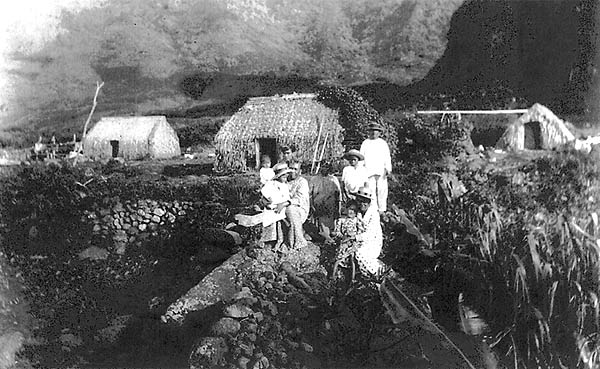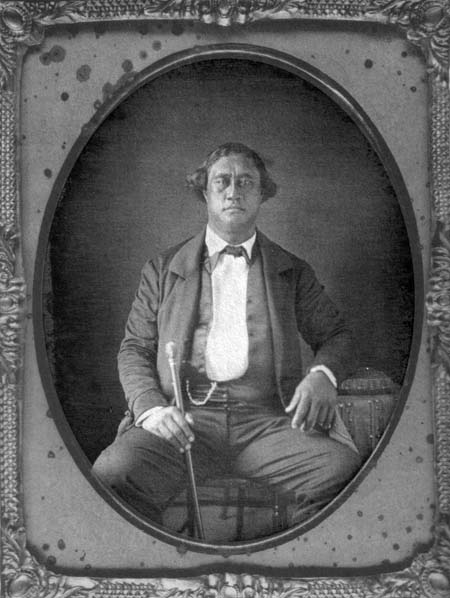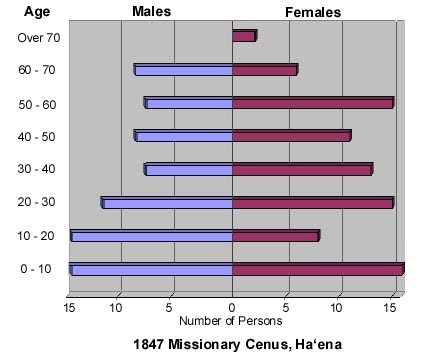 |
 |
 |
|||||
|
|
|
|
|
|
|
|
|
|
|
|||||||
|
|||||||
|
An unidentified family at Ke‘e in the
early 1900s.
|
"The ruling families of Kaua‘i were the highest tapu chiefs in the group," wrote Abraham Fornander in 1878. This is "evident from the avidity with which chiefs and chiefesses of the other islands sought alliances with them. They were always considered as the purest 'blue blood' of the Hawaiian aristocracy..." It is said that Ha‘ena was always ruled by a woman. How far back this tradition goes and who these chiefesses were is not certain. But at the beginning of the 19th century, of two major figures in leadership at Ha‘ena, one of them is the chiefess, Kekela-a-ka-lani-wahi-kapa‘a. Kekela was the konohiki who managed the ahupua‘a under ali‘i Abner Paki. She was also the sister of Abner Paki's mother, and the sister-in-law of Kamehameha. During Kamehameha's conquest of the Hawaiian Islands, Kaumuali‘i--the ruling chief of Kaua‘i--had sent his nephew Kamaholelani as an emissary to Kamehameha's court to discuss a truce. Kamehameha presented the recently widowed Kekela to Kamaholelani as a wife. Kekela returned to Kaua‘i and with Kamaholelani, settled at Lumahai, two ahupua‘a down from Ha‘ena, and which had been given to them by Kaumuali‘i. Kamaholelani passed away in 1820, and in a brief civil strife in 1824, land on Kaua‘i was redistributed to chiefs from O‘ahu and Maui. Kekela returned to O‘ahu, probably having lost her land, but in 1837 was appointed as konohiki of Ha‘ena. It is said that in the Mahele, she encouraged commoners to file land claims, resulting in a higher density of kuleana land tracts than found in other areas. Her story is linked with the chief of the time, Abner Paki.
|
||
|
|
||
Ku-ho‘oheihei-pahu (Abner) Paki
|
Abner Paki was a prominent ali‘i. The father of Bernice Pauahi Bishop--after whom the Bishop Museum is named-- was guardian of Lydia Kamakaeha, who would become Hawai‘i's last monarch, Queen Lili‘uokalani. Carol describes as Paki as "a chief of the old tradition. He resisted Christianizing and together with Liliha (widow of Oahu governor Boki and guardian of Kamehameha III) were seen as the last remaining vestiges of the old native order. Paki had considerable political and economic responsibilities; he was placed in command of sandalwood expeditions on Oahu...and was later given charge of the Fort and its supporting lands of Punchbowl and Waikiki. Furthermore, in three days he rallied several hundred men to construct the tremendous Nu‘uanu irrigation system which supplies the numerous taro pondfields begun by Kamehameha in this valley after the battle of Nu‘uanu. This irrigation system is known even today as Paki auwai.... "Paki understood traditional management of water and land resources and would encourage enhancement of these resources for higher crop yields. Not only did he possess an excellent working knowledge of land and water systems, but he was charismatic and firm in his execution of such improvements" (Silva 1995: 27).
|
||
|
|
||
Land apportionment in Ha‘ena resulting from the Mahele must be considered in relationship to the population of the time. Two census counts taken by missionaries are presented below.
|
||||||||||||||||||||||||||||||||||||||||||||||||||||||||||||||||||||||||||||||
| Total: |
116 |
| Adults: |
100 |
| Minors: |
16 |
| Deaths within the last year: |
4 |
| Births within the last year: |
1 |
Source: Schmitt 1973: 26
1847 Census, Ha‘ena, Kaua‘i
| Age Group: |
Total: |
|
Females: |
| All Ages: |
|
|
|
| Children under 5: |
16 |
|
9 |
| Children, 5 to 10: |
15 |
|
7 |
| From 10 to 20: |
23 |
|
8 |
| From 20 to 30: |
27 |
|
15 |
| From 30 to 40 |
21 |
|
13 |
| From 40 to 50: |
20 |
|
11 |
| From 50 to 60: |
23 |
|
15 |
| From 60 to 70: |
15 |
|
6 |
| Over 70: |
2 |
|
2 |
| Blind: |
2 |
||
| Deaf: |
1 |
||
| Births: |
|
||
| Deaths: |
|
Source: Schmitt 1973: 26
A look at the figures described in the 1847 Census shows a healthy and growing population. These numbers, arranged in a population pyramid (below), show a distribution characteristic of growth: their are a good number of children and young people given the adult population. This is significant because of the negative impact of introduced diseases during the first few decades of the 19th century, and the drop in fertility that resulted. Ha‘ena at this time, however, appears to be healthy, and has a larger population in 1847 than it did in 1835.
|
|
As elsewhere in the islands, the results of the Mahele will not benefit all of these people initially. But as we will see, at Ha‘ena even those who did not receive land did not find themselves displaced from life and livelihood. This was due to efforts by the residents in the aftermath of the Mahele.
|
||
|
|
||
| |
| |
|
|
 |
| Ha'ena Home | Map Library | Site Map | Hawaiian Islands Home | Pacific Worlds Home |

|
|||
| Copyright 2001 Pacific Worlds & Associates • Usage Policy • Webmaster |
|||






